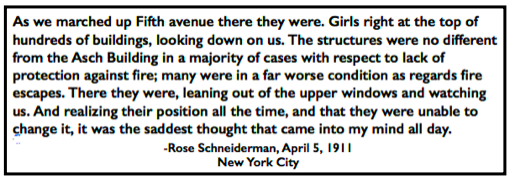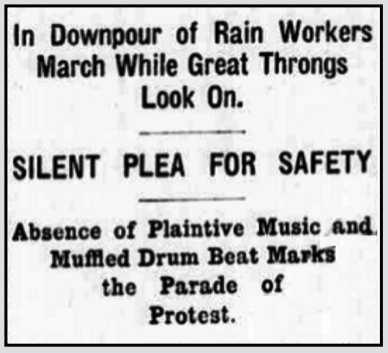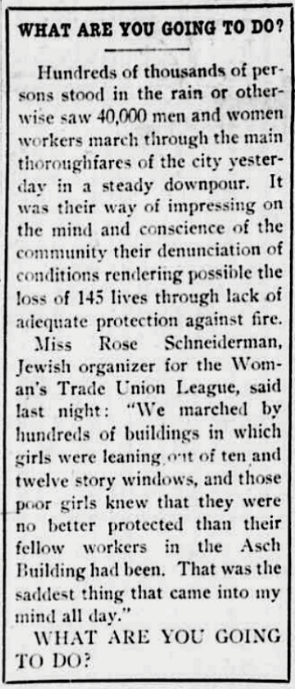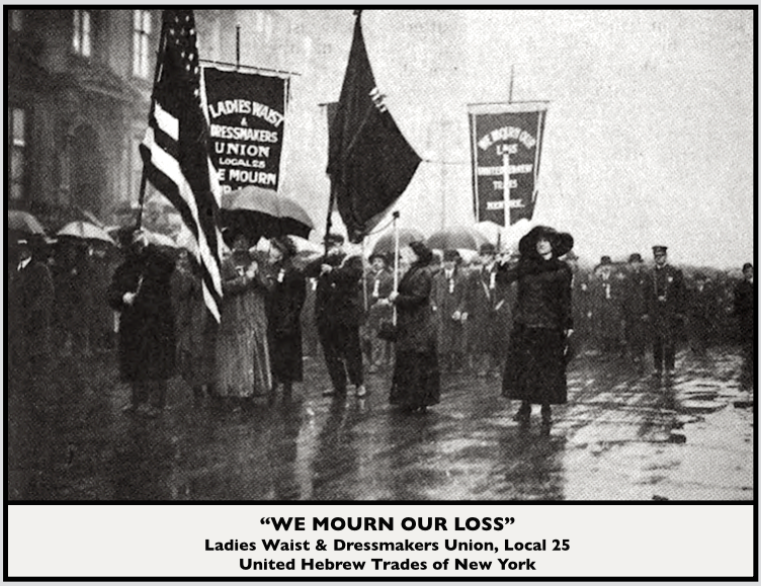 ———-
———-
Hellraisers Journal – Saturday April 8, 1911
Women March in Cold Rain for Unidentified Victims of Triangle Fire
From the New York Tribune of April 6, 1911:
There was majestic silence and sullen rain. But it was a silence that spoke. Their fellow workers to the number 145 had been launched into eternity as the result of the Asch Building fire on March 25. And so [thousands] marched in murmurless protest through the principal streets of the city yesterday.
The steady downpour did not divert girls who were without umbrellas, without hats, without overshoes and rubber coats from their determination to show public honor to fellow workers who had perished…..
If the day had been filled with sunshine the funeral procession would have been impressive. Perhaps, however, there would then have been the chance to minimize the intensity of feeling existing among the marching members of the sympathizing unions. Only a high devotion and sense of duty could be responsible for yesterday’s protest.
Low hanging clouds and fog shrouded the tops of buildings. The Metropolitan tower was invisible above its clock. There was the suggestion of smoke in the atmosphere. The streets were filled with puddles of water. Women in lamb’s wool coats, accustomed to ride in automobiles, were splashed by passing vehicles as they trudged along in the beating rain, anxious to demonstrate the sympathy felt by the Woman Suffrage party. Hundreds of thousands stood on the sidewalks, their umbrellas appropriately indicating unbroken borders of black. Policemen, mounted and afoot, wore regulation black raincoats.
There was no playing of plaintive music, no muffled drum beat. The spectacle was without ostentation, flourish or display. Banners bore the legend “We mourn our loss” in black and white. There was a solemn expression on the faces of those who marched and those who watched from office buildings, stores and private houses. Flags on public buildings were at half-mast; thousands of other structures were draped in funeral decorations.
Thousands Watch Parade.
The dolorous procession, representing an organized expression of protest, filed by for two hours, gaining continually in intensity, while hundreds of thousands of persons saw and understood.
Miss Rose Schneiderman, Jewish organizer for the Woman’s Trade Union League, who was a speaker at the mass meeting on Sunday in the Metropolitan Opera House, was too ill to march without the support cheerfully provided by Miss Mary Dreier and Mrs. Raymond Robins, New York and Chicago presidents of that organization. Miss Schneiderman was between them, and by hanging on their arms managed to walk the entire distance and to stand an hour and a half at Washington Place waiting for the downtown section to appear. These and thousands of other women marched without umbrellas, with an apparent grim satisfaction that, in a sense, they could wear sackcloth and ashes in so good a cause.
Miss Schneiderman said, when asked about her condition at the close of the five-hour drenching:
Oh, please do not speak of my feeling ill. I have been suffering from a cold, that is all. We don’t know how sick the other girls were. This parade has been the only thing that will demonstrate to the people at large the enormous responsibility resting on them to see to it that fire protection is given these thousands and thousands of factory workers. As we marched up Fifth avenue there they were. Girls right at the top of hundreds of buildings, looking down on us.
The structures were no different from the Asch Building in a majority of cases with respect to lack of protection against fire; many were in a far worse condition as regards fire escapes. There they were, leaning out of the upper windows and watching us. And realizing their position all the time, and that they were unable to change it, it was the saddest thought that came into my mind all day.
Miss Dreier said that she could not recall in the history of the ages any funeral procession, or parade of any kind, that could be likened unto yesterday’s. Her eyes sparkled, her cheeks were flushed, and all, she said, because the men and women workers had done so nobly.
Women March Without Hats.
Chimes denoting it was 1:30 o’clock sounded simultaneously with the movement of the Fourth avenue division from 22d street and Fourth avenue. The division was composed largely of women, most of whom, for some unexplained reason, did not wear hats or overshoes. They had been standing in streets east of Fourth avenue for an hour. Women held babies and watched from the curb-stone. Most men and women in the procession wore a white badge, on which was printed in black letters, “We mourn our loss.”
[…..]
There were said to be sixty union in line. By far the greatest number of paraders belonged to various garment workers’ organizations, but not all. There were Hebrew actors, vaudeville singers and entertainers in the line, as well as others from every conceivable trade.
Each union carried its red and blue banner, draped in black. The badges that each individual wore carried the everywhere visible inscription: “We Mourn Our Loss.” Some of th insignia were celluloid buttons. Others were streamers of ribbon pinned to the coat.
Most of the marchers were persons under forty years old and typical of the sewing machine employment. A white haired woman wore rubber boots and walked the entire distance. One eighty-year-old woman tottered along for a time with the first section. She was said to be the mother of one of the girl victims. But she was too weak to walk far. After a few blocks she faltered and would have fallen, except tor friends who carried her to the sidewalk and took her home…..
[Photograph and emphasis added.]
~~~~~~~~~~~~~~~~~~~~~~
SOURCE
New York Tribune
(New York, New York)
-Apr 6, 1911
https://chroniclingamerica.loc.gov/lccn/sn83030214/1911-04-06/ed-1/seq-1/
https://chroniclingamerica.loc.gov/lccn/sn83030214/1911-04-06/ed-1/seq-2/
IMAGE
Triangle Fire, re NYC Apr 5, ISR p670, May 1911
https://www.marxists.org/history/usa/pubs/isr/v11n11-may-1911-ISR-gog-Corn-OCR.pdf
-for another view of banners:
http://trianglefire.ilr.cornell.edu/slides/184.html
See also:
Tag: Triangle Shirtwaist Factory Fire
https://weneverforget.org/tag/triangle-shirtwaist-factory-fire/
“What is to be Done” by Martha Bensley Bruere
https://trianglefire.ilr.cornell.edu/primary/testimonials/ootss_MarthaBensleyBruere.html
-first published in WTUL’s Life and Labor of May 1911
https://babel.hathitrust.org/cgi/pt?id=uc1.b3859487&view=2up&seq=147
~~~~~~~~~~~~~~~~~~~~~~~~~~~~~~~~~~~~~
Mayn Rue Platz – Vocolot
Lyrics by Morris Rosenfeld



